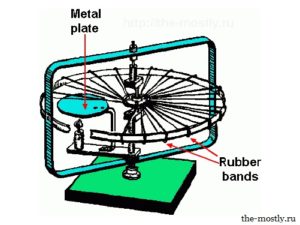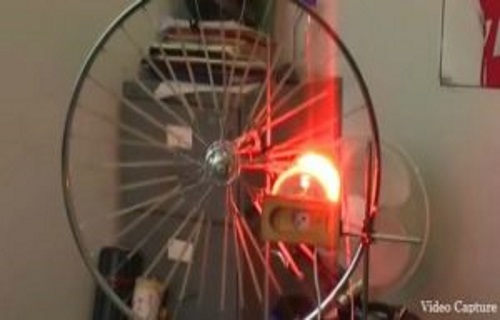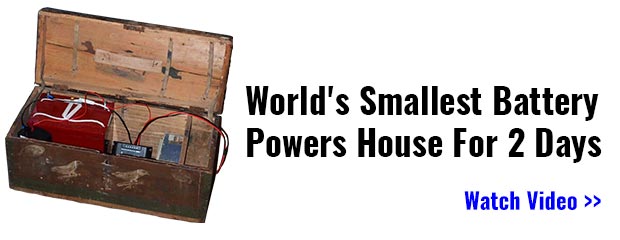The rubber band engine is cheap and easy to make, and can be adapted easily enough to run on heat from a solar capture device.
This type of engine isn’t the most efficient device, but if you have been looking into power generation systems, then you already know that most systems are inefficient.
To generate a reasonable amount of electricity, the device either has to be very large or made from materials that are very expensive. Add in the cost of batteries and voltage regulators, and it may seem impossible to gain energy independence.
But why wouldn’t give this little fellow a chance and try to make one for your homestead?
How Does a Rubber Band Engine Work?
I have long been a fan of work with smaller devices that generate small amounts of energy, and then pooling that electricity to gain a reasonable amount of power.
While the rates may vary considerably, as well as the amount of heat required, most solid objects will expand when you heat them and contract when they cool. Rubber is like water in the sense that it will also expand as it cools and contract as it heats up. Unlike water, however, it takes much less heat to cause rubber to contract. Therefore, when arranged in combination with metals or other materials, heating up rubber will cause an object to disbalance. This “disbalancing” will cause the object to spin. As the object spins, you can use that motion to generate electricity with magnets and coils.
GREEN ENERGY – Click Here to find out how you can build your own energy generator.
Will Something Other Than Rubber Bands Work?
Thinking about materials that you can easily obtain, there are no substitutes that will work as well as rubber bands, or be as cheap to obtain in this particular energy generating design.
There are some things you can try and also look for as new technologies emerge:
- Metals expand and contract at different rates. Therefore, it is possible to obtain alloys that expand much faster when heated, and also cools and contracts faster when away from a heat source. Unfortunately, it may take a bit more energy than it would take to create the same amount of change in a rubber band.
- If you decide to work with metal alloys, try and see if a spring shape works better than something similar to rubber bands. As the spring relaxes and tenses, some additional capacity to turn the wheel may be produced from this shape.
- Water is the only other readily available substance that expands as it turns to ice, and then contracts as it shifts from ice back to water. It takes a good bit of energy to cause water to shift between its four phases of solid, water, gas, and triple state. Nevertheless, if you work with smaller quantities of water and generate small amounts of steam that are held in tubes, it may be possible to push a wheel out of balance in a way similar to one of the most basic rubber band engine designs.
- As research continues on nano-technologies and other studies that lead to development of new materials, it is entirely possible that some solid will emerge that behaves like rubber. If this material turns out to be more durable than rubber bands, then it may be worthwhile to see if you can obtain some and try to build a power generating engine with it.
What happens if we lose power indefinitely — foods that require freezing or refrigeration for long term storage are going to go bad? Emergency food storage in advance will be the only way to feed yourself and your family.
As a prepper, you may feel a bit frustrated because this particular engine relies on a commodity that may not be available after SHTF.
There are ways to make rubber on your own from various plants, and once you design your first rubber band engine, experiment with growing plants that produce a sap that can be turned into rubber (dandelions, for example). You may have to make thicker bands in order to produce the same level of durability as you will get from commercial rubber bands, it is still worth the effort.
Different Ways to Build the Basic Engine
When building a rubber band heat engine, you will need to make sure that you control the amount of heat reaching the rubber bands. Too much heat can damage the rubber bands, so you will usually find that “less is better”.
You will also need to decide whether you will use a bath of warm water, or simply heat up the air around the rubber bands in order to make them contract. Even though you can use anything from  old bicycle wheels to cardboard to build the frame for the rubber bands, the engine must have the following parts no matter whether you decide to heat up air or water:
old bicycle wheels to cardboard to build the frame for the rubber bands, the engine must have the following parts no matter whether you decide to heat up air or water:
- rubber bands
- a central shaft
- one or more disks that can be mounted to a central shaft. This disk will also have to act as a support for the rubber bands. It will also need to be sturdy enough so that you can mount magnets on it.
- a means to shield one half of the rubber bands from heat so they expand as quickly as possible
- a way to heat up the air or water
Of all the designs featured on the Heat Engines page, the design by William E. Wiegand will probably lend itself the best to a wide range of power sources.
It also has a fairly large vertical frame, so there is also plenty of room for adding coils. Needless to say, for anyone interested in making a small central coil, this may also be an ideal way to build an electric motor that runs on heat.
X Powering Methods for a Rubber Engine
Many people are surprised to find out that a rubber band engine is very easy to power. A candle, or even incandescent light bulb will provide enough heat to cause the rubber bands to contract.
In fact, just about any source of heat, even if it is generated as a secondary process (for example, heat thrown off from a running engine) can be used to power the rubber band engine. Just make sure that you can shield the rest of the device so that the central disk keeps spinning.
Here are just a few simple things you can use to power the rubber band engine that will serve a dual purpose:
Candle heater
Set a candle heater to one side of the rubber band engine. As you will recall, this simple device requires little more than a few clay pots and zinc free washers. With 4 tea lights, you can heat up a small room for 2 – 3 hours and run the rubber band engine at the same time.
Alcohol, and Rocket stoves
Why not generate some electricity while you are cooking on these versatile stoves? As with the candle heater, just set the rubber band engine to one side of the stove where it will receive sufficient heat. Camp fires, and any other stove that throws off heat can be used for the same purpose.
Using a rubber band engine instead of materials that generate electricity based on thermal transfer will be cheaper and easier to develop into larger applications in the long run.
Other Sources
If you are serious about breaking away from commercial electricity or other commercial power sources, then you will already realize that solar and wind power offer you the best options. These systems have been hijacked by dirty and expensive “green” technologies, there is still a lot you can do at the consumer level to take advantage of them.
The sun produces plenty of heat that can be concentrated, and stored so that you can run the rubber band engine in many different kinds of weather.
Here are just a few devices you can make from stuff in your trash can or around the yard and use to power the rubber band engine:
Solar can heater
This device uses little more than old food cans, a wooden frame, some glass or plastic, and pipes in the center of each can. Basically, in this system, the cans are exposed to the sunlight, and cause the air or water in the central tubes to heat up.
From there, all you have to do is let the hot air flow into a room in your home, or let the hot water circulate in a water radiator. To run the rubber band engine, it is just as easy to make a second set of pipes that will blow hot air directly onto the engine.
Solar cooker
These devices can produce temperatures hot enough to cook meat, boil water, and bake bread. Just set up a metal coil in the bottom of the solar cooker and set the other end under a metal plate on one side of the rubber band engine. Do not forget to check the temperatures often so that you do not over heat the rubber bands.
Shiny object
The simplest and easiest way to concentrate heat from the sun is to use a shiny object that bounces sunlight onto a piece of metal. As the metal heats up, the radiant energy will disburse near the rubber band engine.
When experimenting with this system, be careful to watch as the sun shifts so that the mirror does not wind up bouncing heat onto dry grass or something else that can catch fire. It can take only a few seconds for to start a fire this way, and a matter of minutes for it to go out of control.
Plastic solar lenses
Water absorbs a lot of heat, and can also hold onto it for a reasonable amount of time. If you are interested in purifying water, then you may already know that clear plastic solar lenses or even a simple clear plastic bottle are very important for this purpose. If you let a contained source of water heat up, then you can also use that heat to power the rubber band engine.
As with the solar cooker, you will more than likely need to use some type of metal to transfer the heat from the collector to one side of the rubber band engine. You can also use styrofoam or other insulators on the metal so that as little heat as possible is lost on the way to the rubber band engine.
Needless to say, if you choose to build a rubber band engine that is designed to work with warm water, then you will not need to concern yourself with transporting the heat to another location.
Friction
Most people will tell you that friction is a necessary evil at best, but friction also generates heat. If you are interested in harnessing wind power to power the rubber band engine, you may look for ways to generate friction as the bladed (or bladeless depending on the design you choose) system turns. You can still use oils and other lubricants to reduce wear on parts, and still gain plenty of heat from friction generated by the parts passing each other. It may be as simple as adding a band around standard wind turbine blades (or make them smaller to compensate for the added wind power to overcome drag) that will produce friction.
How to Get Electricity From the Rubber Band Engine
Once you master assembling coils and magnets to generate electricity, using the rubber band engine will not be much different. Even though you may be tempted to make a central coil, do not forget these coil types are harder to wind. Magnets also weigh less and can be distributed more easily, so I still recommend using them on the spinning area of any given power generation system and then leave the coils stationary.
When generating electricity using rubber bands, remember that a rubber band does not have a lot of strength. Even if you can get the wheel spinning quite fast, it will take several modules going on at one time to generate significant amounts of power.
You are better off building ten smaller units that spin faster than one unit that does not move as well or breaks down quickly because of the wear and tear on the rubber bands.
Finally, as with any other power generation system, you will still need some way to even out the current produced, and then store it for later use. You can use anything from earth batteries to store electricity to twisting ropes that can be used later on to spin the wheel in the opposite direction and produce more electricity.
If you have some rubber bands sitting on your desk or in a drawer somewhere, you may not realize that these flimsy objects may be a key to generating electricity, even if they only produce a few volts of electricity, but enough to power smart phones, flashlights, or other useful small devices.
They are also a perfect way to gain a good introduction into harnessing solar power, or even how to build units that can be combined to generate even more power.
Click the banner below for more!
Our grandfathers had more knowledge than any of us today and thrived even when modern conveniences were not available. They were able to produce and store their food for long periods of time. The Lost Ways is the most comprehensive book available. All the knowledge our grandfathers had, in one place.Here’s just a glimpse of what you’ll find in the book:
The Lost Ways is a far–reaching book with chapters ranging from simple things like making tasty bark-bread-like people did when there was no food-to building a traditional backyard smokehouse… and many, many, many more!
Books can be your best pre-collapse investment.
The Lost Ways (Learn the long forgotten secrets that helped our forefathers survive famines,wars,economic crisis and anything else life threw at them)
Survival MD (Best Post Collapse First Aid Survival Guide Ever)
Conquering the coming collapse (Financial advice and preparedness )
Liberty Generator (Build and make your own energy source)
Backyard Liberty (Easy and cheap DIY Aquaponic system to grow your organic and living food bank)
Bullet Proof Home (A Prepper’s Guide in Safeguarding a Home )
Family Self Defense (Best Self Defense Strategies For You And Your Family)
Survive Any Crisis (Best Items To Hoard For A Long Term Crisis)
Survive The End Days (Biggest Cover Up Of Our President)
This article has been written by Carmela Tyrell for Survivopedia.


